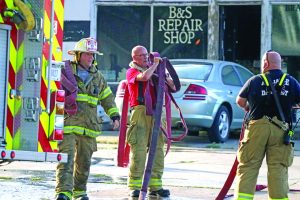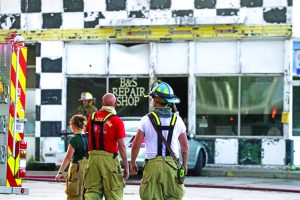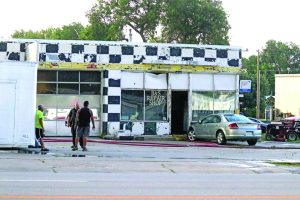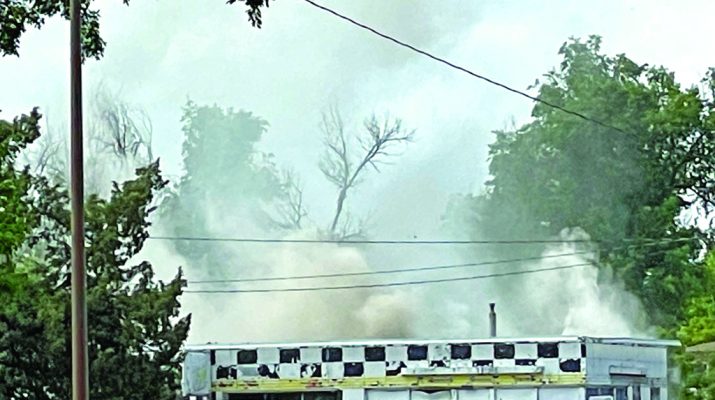A fire that broke out at B&S Repair is believed to have been ignited by lithium battery chargers, and was deemed to be accidental in nature. The fire led to extensive smoke damage to the building, though, according to officials, is believed to be structurally sound.
Alliance Volunteer Fire Department Chief Troy Shoemaker said that they received the report of a fully-involved fire at B&S Repair at 4:01 p.m. on Thursday.
“Upon my arrival, we just had smoke coming from the roof and the eaves, and no active fire showing,” said Shoemaker. “We sent an entry crew of two in, and when we forced entry through the front door, the smoke had banked all the way to about two foot off the floor. We made the decision to vertically ventilate, which means cut a hole through the roof of the business. When we did that, it gave us an avenue for smoke to be released from the structure, and it helped with the location of the fire.”
When the entry crew pinpointed the location of the fire, Shoemaker said they began efforts to extinguish it.
“The fire was not in the service part of the building as much as it was in a storage, office room,” Shoemaker said. “The biggest challenge was, the heat played a part into it, but it was finding the fire. When we located the fire, it was not obvious because of the amount of smoke that we had in the structure. When we were doing ventilation, we also had a crew inside, so we were doing two tasks at once. That was probably the biggest challenge was locating the fire and getting it overhauled so that we didn’t rekindle. So, we spent a lot of time on the overhaul portion of the event.”
Shoemaker explained that they requested mutual aid from Hemingford for manpower and the potential need for a pumper.
“Fortunately, we just needed the manpower because of the heat, so we could cycle crews in and out,” said Shoemaker. “Between Alliance and Hemingford, we had about 21 firefighters involved with the fire. We had two pumpers, an aerial, a rescue truck, an ambulance, and utility vehicle on scene. We deemed the fire controlled at 17:35 (5:35 p.m.) and we started releasing equipment at about 8:40. Shortly after that, we got toned out to a grass fire west of town. I didn’t terminate command on the fire until a few minutes before 11, and that was after the investigation was complete.”
The State Fire Marshal out of Ogallala, Shoemaker explained, was busy at the time they issued a request, so an investigator from Basset traveled to Alliance to begin the investigation until the investigator from Ogallala arrived on scene.
The fire was deemed to be accidental in nature, Shoemaker explained, and was likely caused by lithium-ion batteries and charging.
“The area where the fire originated at had some lithium battery chargers, and that is what they (the investigators) believe caused the problem,” said Shoemaker. “
Shoemaker advised people to follow the guidelines and to take precautions when charging lithium batteries. He said it is important to use the batteries in the way they were made and for the purposes they were listed. He said that once a battery is charged, it is best to put it in the device right away. When it comes to charging devices like cell phones, Shoemaker said it is important to not let them charge on things like pillows, beds or couches, as those are easily-ignitable materials.
“You only really want to use the charging cord and charge the batteries when the batteries need to be charged, and not continually charge your battery,” said Shoemaker. “Once the battery is charged, you want to take the battery out of the charger after it’s fully charged. What happens is a battery can get overcharged and overheat, and it’s called thermal runaway. Once that battery starts to do that thermal runaway, you can’t stop it. It can overheat, catch fire and explode. Those batteries store such a large amount of energy in such a small amount of space, and not that B&S did anything wrong, because we don’t believe they did. Sometimes the battery itself can be defective. There’s nothing you can do about it, and sometimes you don’t find that out until there’s an issue.”
He provided the following document with safety guidelines for using lithium-ion batteries:
Shoemaker estimated the damage caused by the fire at $200,000, though he said that estimate may be low. Shoemaker said there was one vehicle inside of the repair shop at the time of the fire, though the fire was located in a separate part of the building.
“The building, I believe, is still structurally sound,” Shoemaker said. “They’ll have to repair their roof, but it’s a block building. I think they could probably rehab it and continue to do what they are doing in that location, in that building, but again, that’s obviously up for insurance companies and those folks to figure out what they want to do. That whole building took a lot of smoke and a lot of heat.”






(Photos by Lori White and Shaun Friedrichsen)

